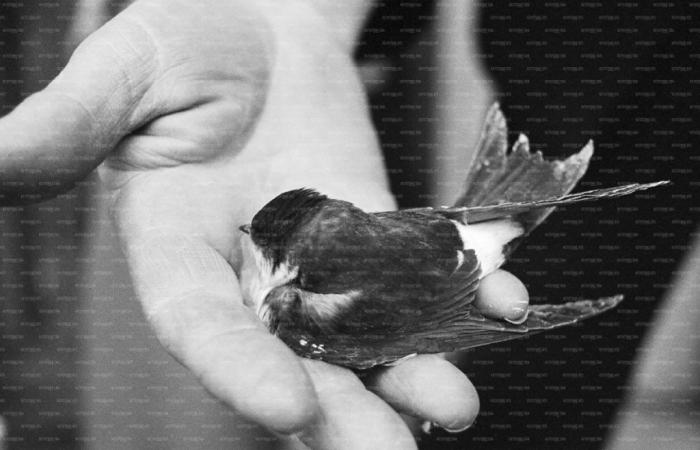Keystone-SDA
This content was published on
October 6, 2024 – 1:00 p.m.
(Keystone-ATS) When the early winter of 1974 killed thousands of swallows, surprised before their departure on migration, the airline Swissair came to the birds’ aid. She transported more than a million in boxes to the South.
The barn or chimney swallows, transported in suitable cardboard boxes, traveled as “additional baggage” on the planes of the former Swissair (today Swiss), we learn from reading the archives. However, this was only the most spectacular part of the rescues.
In Switzerland, but also in Germany, environmental associations as well as numerous volunteers have launched a vast operation to protect species. Birds were captured: for entire nights, swallows were taken from their nests or roosts to feed them minced meat and mealworms.
With full stomachs, migratory birds were then sent by car, train and especially by plane to warmer regions. You should know that birds do not go south because it is cold, but because they can no longer find food, explains Livio Rey of the Swiss Ornithological Station of Sempach (LU) to the Keystone press agency. -ATS.
When it’s cold, there are almost no insects in our country. Birds that feed on insects therefore leave in winter, while those that can change their diet or that also eat seeds anyway stay here, explains the specialist.
Internal clock and climate change
While short-distance migrants react rather flexibly to weather conditions, the timing of their departure is, on the other hand, strongly ingrained in the genes of long-distance migrants. “From a certain ratio of length of days and nights, hormones are activated. That’s when the migratory commotion begins among the birds,” Rey explained.
This internal clock is no longer as reliable, however, due to global warming. Spring starts earlier every year in Europe. However, long-distance migrants change their agenda very little. They thus miss the best conditions for their reproduction period and, according to Mr. Rey, sometimes have fewer young or can feed them less well.
Early hellos
The cuckoos are the first to leave Switzerland. From mid-July, they leave for their winter regions south of the Sahara. Shortly after, other long-distance migrants such as the black swift, the black kite and the oriole follow. “In principle, the earlier the birds leave, the more likely they are to winter in Africa,” according to the Sempach expert.
Among short-distance migrants, some birds that previously always went south in winter, however, remain more often in Switzerland. This is particularly the case for white storks and red kites.
For some birds, Switzerland is the south
With the annual departure of migratory birds from Switzerland, bird migration is not over, Mr. Rey further emphasized. Indeed, the lakes of Switzerland are attractive winter quarters for many aquatic species from northern Europe. Around half a million of them spend the winter there, according to regular censuses.
The number of these visitors from the North wintering in Switzerland is decreasing, however, because, again due to climate change, the lakes almost no longer freeze in winter, even in the nesting areas of many birds. In January 2024, only around 360,000 individuals were recorded in Switzerland, including border waters.
Every year, an estimated 50 billion migratory birds fly to their winter quarters in the fall across the planet. An estimated five billion birds make the journey between Europe and Africa alone each year.






